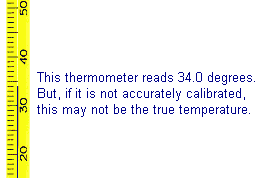![]()
| Accuracy indicates how close a measurement is to the accepted value. For example, we'd expect a balance to read 100 grams if we placed a standard 100 g weight on the balance. If it does not, then the balance is inaccurate. |  |
| Precision indicates how close together
or how repeatable the results are. A precise measuring instrument will give very
nearly the same result each time it is used. There are several ways to report the
precision of results. The simplest is the range (the difference between the highest
and lowest results) often reported as a
|
|
|||||||||||||||||||||||||||||||||||||||
| Which of the following sets of data is more precise, based on its range? |
Both accuracy and precision affect how many significant
digits can be reported. Manufacturers will usually specify the accuracy and
precision to be expected from their equipment as a ![]() uncertainty.
uncertainty.
It is quite possible for an instrument to be precise, but inaccurate. For example, consider the chains used to measure the first down in a football game. They are supposed to be ten yards long. But what if they were only 9 yards, 35 inches? You would certainly get the same precise measurement each time you used the chains, but you wouldn't be getting the correct accurate measurement. Both teams would not have to go quite ten yards to get a first down, and the error is so small you probably wouldn't even notice it. However, there probably have been football games played where one inch would have made a difference to the outcome of the game. In science and in football, our measurements should be both accurate and precise.
Of course, even precise and accurate equipment can be used incorrectly. If the chains were the proper ten yards long, it would still be possible to get an imprecise measurement for first downs. The chains must be stretched tightly, and they must be marked from the proper location on the yard line markers.
| The thermometers found in high school labs are often more precise than they are accurate. It is quite easy to read a thermometer to the nearest 0.2 oC. However, the overall calibration can often be off by a degree or more. The temperature shown on the thermometer at the right can be read to 34.0 oC. However, if the thermometer is not of high quality, it would be easy for the real temperature to be off by as much as a degree or more. Iin other words, the temperature could really be as high as 35 or as low as 33 oC, although the thermometer reads 34.0. |  |
| In which of the following examples would the precision of a thermometer be more important than its accuracy? |
Try the section quiz to check your understanding of this topic.